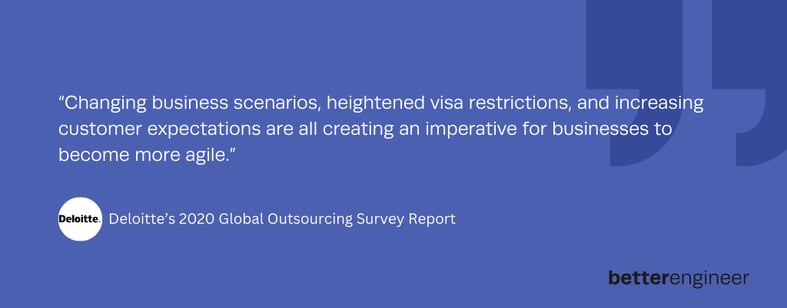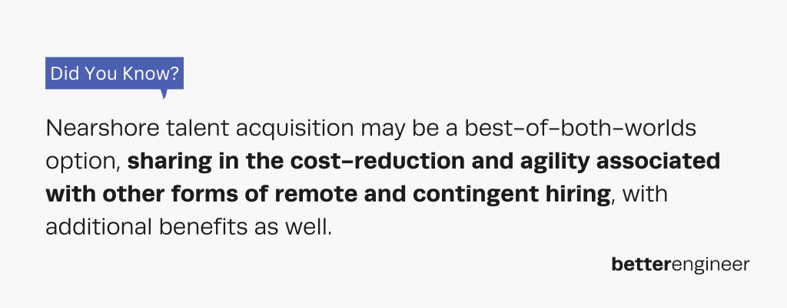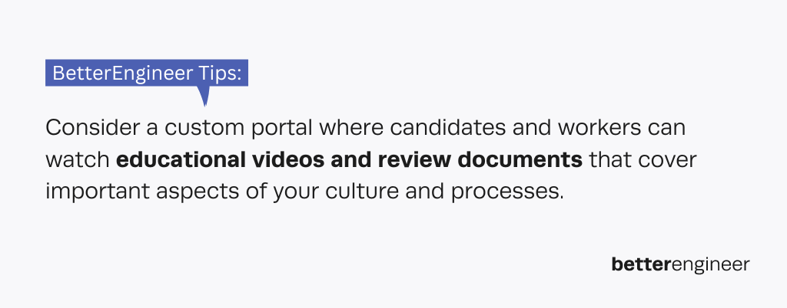%20(1317%20x%20739%20px)%20(5)-1.png)
2020: a year of tumult and change, as well as increased unemployment and financial uncertainties resulting from the COVID-19 pandemic. How will this affect hiring in 2021? What long-term or medium-term remote hiring trends will continue, and what new trends should you watch? How are other companies handling remote hiring? One overarching theme we’re seeing is that agility is more vital than ever. According to Deloitte’s 2020 Global Outsourcing Survey report, “Changing business scenarios, heightened visa restrictions, and increasing customer expectations are all creating an imperative for [businesses] to become more agile.” Already trending heavily before COVID, remote hiring is one obvious, agile solution to the challenges coming in 2021. Remote hiring can:
- Reduce staffing costs
- Meet short-term and contingent workforce needs
- Provide access to a larger talent pool
- Poise companies to weather industry shocks
- Help companies make strategic pivots

2021 Strategies for Remote Hiring Success
1. Consider Offshore Outsourcing:
Offshore outsourcing, or “offshoring,” is the hiring of third-party companies or contractors in other countries to perform work that would otherwise be done internally. The primary driver of offshoring is cost reduction, so countries with very low labor costs, such as India, China, and Eastern and Southern Europe, are popular offshore locations. By offshoring, companies can find the talent they need while easing costs. As Deep Patel says in Forbes, “By searching a global talent pool, it’s easier to find the right talent at the right price.” However, if you’ve ever had to set up conference calls for stakeholders in, say, San Francisco, London, and Mumbai, you know that the lack of overlapping work hours can be a real headache.
.png?width=787&height=309&name=%234C60B2%20(1).png)
There are other cons to consider, including:
- Potential communication and cultural issues
- An expanded number of public holidays (Maharashtra, the state of Mumbai, had 17 public holidays in 2020, many of which do not coincide with the 10 US federal holidays.)
- Expensive travel costs, if travel is required
- Potential ethical problems with hiring in countries with few labor protections
2. Research Rural Onshoring:
Rural outsourcing, sometimes called “onshoring,” is often same-country talent sourcing with an emphasis on recruiting talent from within your country’s borders but outside the usual, often expensive, urban centers. Onshoring has many of the benefits of other forms of outsourcing, as well as the following:
- Shared first language and holidays
- Shared or well-overlapped time zones
- Familiarity with US laws and regulations
COVID has made remote work more common and widely accepted than ever. There’s no reason skilled workers can’t combine high-tech work with a low cost of living—and no commute! Picture your contented employees basking in the sun on the porch of their renovated 19th-century farmhouse as they create code or design graphics. What’s not to love? Well, there are some cons to consider. For one, many rural areas lack fast, reliable internet.
Workers may find themselves without appropriate bandwidth for video meetings and the work they need to perform. Also, cost reduction may not be as marked as it is with offshoring, or the next trend we’ll discuss is nearshoring.

3. Explore Nearshore Options:
Nearshore outsourcing, or “nearshoring,” is the hiring of companies or contractors from bordering countries or countries in the same or similar time zones. For instance, US companies are increasingly seeking talent in Canada and in Latin American countries such as Mexico, Costa Rica, Argentina, and Brazil. Nearshore talent acquisition may be a best-of-both-worlds option, sharing in the cost-reduction and agility associated with other forms of remote and contingent hiring, with these additional benefits:
- Shared or well-overlapped time zones and workdays
- Travel options that are less costly and difficult than offshore options
- Improved cultural integration with the existing core team
- A large pool of fluent English speakers, many of whom have lived in the US or worked with US companies
4. Create a Scalable Process for Hiring:
Hiring is a task that often takes a bewildering amount of time: the process seems to be anything but agile. According to talent-acquisition company ICIMS, in 2019, the average time it took to fill a position was 43 days across all roles—and 66 days for highly skilled tech positions. Be sure to take the time upfront—before you’re in a labor crunch and desperate to hire—to create a repeatable system and well-defined process for prospecting, recruiting, interviewing, and onboarding new talent.
- Determine your larger needs: What skills do your current workforce need to meet current and future goals?
- Determine your specific needs: What projects and tasks need staffing right now?
- Outline your budget and strategies for each part of the process, from prospecting and recruiting to interviewing, hiring, and onboarding. Establish hiring roles and responsibilities.
- After you’ve done the pre-work, begin the prospecting process.
Does all of that sound overwhelming? One of the most scalable options, heavily trending in skilled industries, is using a third-party company to find and filter candidates, to do the hiring for you, or even to hire, manage, and pay contingent workers. (See strategy 7.)

5. Audit Your Tech Stack:
Review your existing technology to support the talent-acquisition process: everything from your prospecting tools, such as LinkedIn and Bullhorn, to remote interviewing technologies, such as Zoom, Skype, and GoToMeeting.
What tools and metrics do you have for gauging the know-how of candidates who seem promising? Consider:
- Do you have a standardized system your prospects and candidates can use to easily submit resumes, portfolios, websites, or work samples?
- What about technical assessment tools? For instance, assessments such as HackerRank tests can give you an idea of someone’s coding skills.
Onboarding remote workers can also be tricky. Do you have a company handbook or other documents that help orient workers, and are they in a location where remote workers can easily find them? Consider a custom portal where candidates and workers can watch educational videos and review documents that cover important aspects of your culture and processes.
Be sure your tech includes a platform, such as Slack, that enables document sharing, real-time chat, and direct messaging; definitely include a channel or other space where remote workers can ask questions. Consider it a space to replace the water cooler or sub in for the ability to pop a head over a cube wall to ask a quick question or request a needed introduction. (Make sure experienced employees are on that channel to answer the questions!)
6. Build Your Online Brand Presence:
Build a strong online brand presence using your website(s), LinkedIn profile, and social media to promote your business and workplace culture. Prospects and candidates should be able to research your workplace and culture online before approaching you.
A note about social media: If you choose to have a social media presence, choose your outlets according to audience and impact. Facebook is different from Twitter is different from TikTok, of course, so be strategic. It is better to have one or two well-curated, engaging feeds than an anemic presence on every site. If you are recruiting from other countries, find out what the best media platforms are for you to use there To blog or not to blog. A blog can be a great way to reach and engage your target audience. But there are a lot of dusty and disused blogs out there. If you do blog:
- Create a publication schedule and stick to it, planning your posts well in advance.
- Use a skilled writer to write about subjects your audience cares about.
- Have the posts edited professionally: misspellings and mistakes undermine your brand.

7. Partner with a Specialized Staffing Agency:
Sourcing talent is extremely time-consuming, and bringing aboard the wrong person or wrong team can be a costly and frustrating mistake. The proliferation of resume pipelines out there means that you may get dozens, hundreds, or even thousands of applicants for one posted position. Increasingly, companies, especially those without a human resources department—or with an already-stretched HR department—are turning to specialized staffing agencies such as BetterEngineer, which recruits remote software engineers, often from Latin America.
BetterEngineer uses an augmented staffing model with a pool of 10,000+ nearshore and onshore software engineers to help clients find the right fit as fast as possible. Augmented staffing allows companies to choose from among highly filtered, well-vetted candidates to find the right team members to fill out their in-house team. Options include using BetterEngineer to:
- Hire a new team member on a contract basis with terms that fit your needs
- Hire a new team member now with the option to make the hire a regular full-time employee in the future
- Pay a one-time recruiting fee and hire straight to your team from day one
- BetterEngineer can swiftly augment client teams with software engineers who enjoy working remotely because we specialize in our industry and maintain a robust talent pool that is vetted for
- Tech expertise
- Workplace methodologies
- Communication skills
- Cultural fit
Want to learn more about BetterEngineer? Get started today.
.webp)
%20(1317%20x%20739%20px)%20(7)-4.png)
%20(1317%20x%20739%20px)%20(8)-2.png)